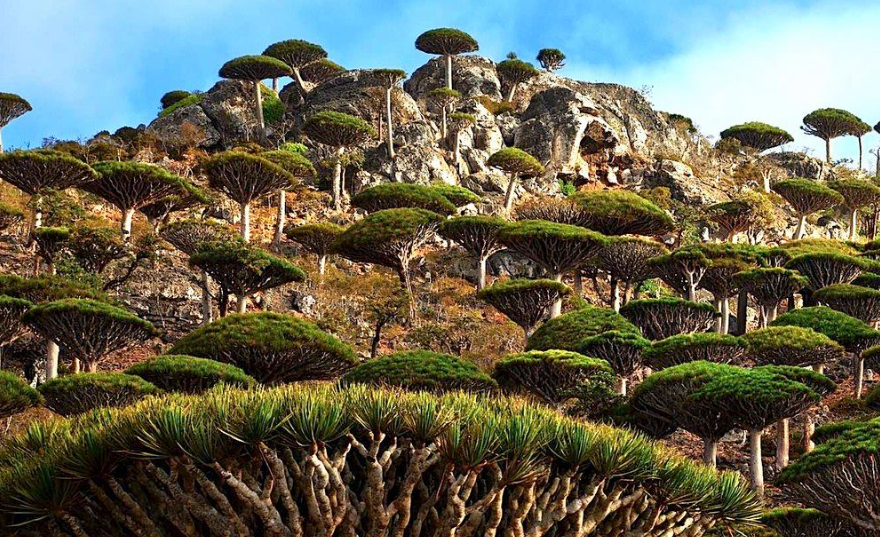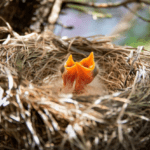
The Rare Dragon Blood Tree: A Majestic Marvel of Nature

Nestled within the arid landscapes of the Socotra Archipelago in Yemen lies one of the most fascinating and otherworldly botanical wonders on Earth: the Dragon Blood Tree (Dracaena cinnabari). This unique tree, with its umbrella-like crown and mysterious crimson resin, has captivated the imagination of botanists, nature enthusiasts, and travelers alike. But what makes this tree so extraordinary, and why is it considered one of nature’s rarest treasures? Let’s dive into the details.
Appearance and Characteristics
The Dragon Blood Tree is immediately recognizable by its unusual shape. It features a dense crown that resembles an upturned umbrella, with branches that extend outward and then upward, creating a mushroom-like appearance. The tree can grow up to 10-12 meters (about 33-39 feet) tall, with some specimens reaching even greater heights.
The leaves are long, stiff, and sword-shaped, growing in clusters at the end of the branches. These leaves are evergreen, persisting for several years before falling off to be replaced by new growth.
The Mythical Resin: Dragon’s Blood
One of the most intriguing aspects of the Dragon Blood Tree is the resin it produces, known as “dragon’s blood.” When the bark or branches are cut, this dark red resin oozes out, resembling blood, hence the name. This resin has been highly valued for centuries due to its various uses.
- Medicinal Uses: In traditional medicine, dragon’s blood has been used for its anti-inflammatory, wound-healing, and astringent properties. It has been a component in various remedies across different cultures.
- Dye and Varnish: The resin has been used as a dye and a varnish for wooden objects, giving them a rich, deep color.
- Incense and Rituals: Due to its aromatic qualities, dragon’s blood has also been used in incense and as a component in various religious and spiritual rituals.
Habitat and Distribution
The Dragon Blood Tree is endemic to the Socotra Archipelago, particularly the island of Socotra, located in the Arabian Sea. This archipelago is often referred to as the “Galápagos of the Indian Ocean” due to its high level of endemism—about 37% of its plant species are found nowhere else on Earth.
The tree thrives in Socotra’s harsh, arid climate, typically growing on the limestone plateaus and granite mountains at altitudes between 300 and 1,500 meters (about 1,000 to 4,900 feet) above sea level. The unique climate and geographical isolation of Socotra have allowed the Dragon Blood Tree to evolve and adapt to its environment in a way that few other plants have.
Ecological Significance
The Dragon Blood Tree plays a crucial role in its ecosystem. Its dense crown provides shade and reduces soil erosion, allowing other plant species to thrive underneath it. The tree’s presence is also vital for the local fauna, offering habitat and food for various insects, birds, and other wildlife.
Moreover, the tree is a key species in maintaining the unique biodiversity of Socotra. The loss of this tree would have a cascading effect on the entire ecosystem, highlighting the importance of its conservation.
Conservation Status and Threats
Despite its remarkable resilience, the Dragon Blood Tree is classified as vulnerable on the IUCN Red List. Several factors contribute to its threatened status:
- Climate Change: The changing climate poses a significant risk to the tree’s habitat. Alterations in temperature and rainfall patterns could disrupt the delicate balance of the Socotran ecosystem.
- Overgrazing: Livestock grazing, particularly by goats, is a major threat to the young seedlings of the Dragon Blood Tree. Without the ability to regenerate, the population of these trees is at risk of declining.
- Human Activity: Expansion of human settlements, infrastructure development, and unsustainable harvesting of the tree’s resin are additional threats.
Conservation efforts are underway to protect this iconic species. These include habitat restoration, the establishment of protected areas, and community education programs to raise awareness about the importance of preserving this natural wonder.
Cultural and Historical Significance
The Dragon Blood Tree has been steeped in legend and lore for centuries. In ancient times, its resin was believed to be the blood of dragons or the sap of a tree grown from the blood of a wounded dragon. The ancient Greeks and Romans prized dragon’s blood for its medicinal properties, and it was even mentioned in medieval texts as a substance of great value.
In modern times, the tree has become a symbol of the unique biodiversity of Socotra and a reminder of the importance of conserving the natural world.
Key Stats at a Glance
- Scientific Name: Dracaena cinnabari
- Common Name: Dragon Blood Tree
- Family: Asparagaceae
- Height: 10-12 meters (33-39 feet)
- Crown Shape: Umbrella-like, upturned
- Leaves: Long, stiff, sword-shaped, evergreen
- Resin: Dark red, known as dragon’s blood
- Habitat: Socotra Archipelago, Yemen
- Altitude Range: 300-1,500 meters (1,000-4,900 feet)
- Conservation Status: Vulnerable (IUCN Red List)
Final Thoughts
The Dragon Blood Tree is more than just a botanical curiosity; it is a testament to the incredible diversity and adaptability of life on Earth. Its unique appearance, valuable resin, and critical ecological role make it a species worth protecting. As we face the challenges of climate change and biodiversity loss, the story of the Dragon Blood Tree reminds us of the fragile beauty of our natural world and the importance of conservation efforts to ensure that such wonders continue to thrive for generations to come.
Hello, I am Aman (: Full Time Traveler :) At the age of 41, in April 2023, fueled by my love for travel and the determination not to remain fixed like a tree, I embarked on a bold journey. Having dedicated 17 years to a corporate job, I chose to transition from a full-time employee to a full-time traveler, driven by the desire to break free from the routine and constraints of a conventional life. Along the way, I not only explored the wonders of travel but also uncovered the transformative power of financial freedom. I realized how it could liberate me to lead a life teeming with adventure, purpose, and fulfillment. Through my blogs, I am passionately sharing my story, aiming to inspire and provide valuable guidance to those, like me, who aspire to weave travel into a life overflowing with limitless possibilities.






















Post Comment
You must be logged in to post a comment.